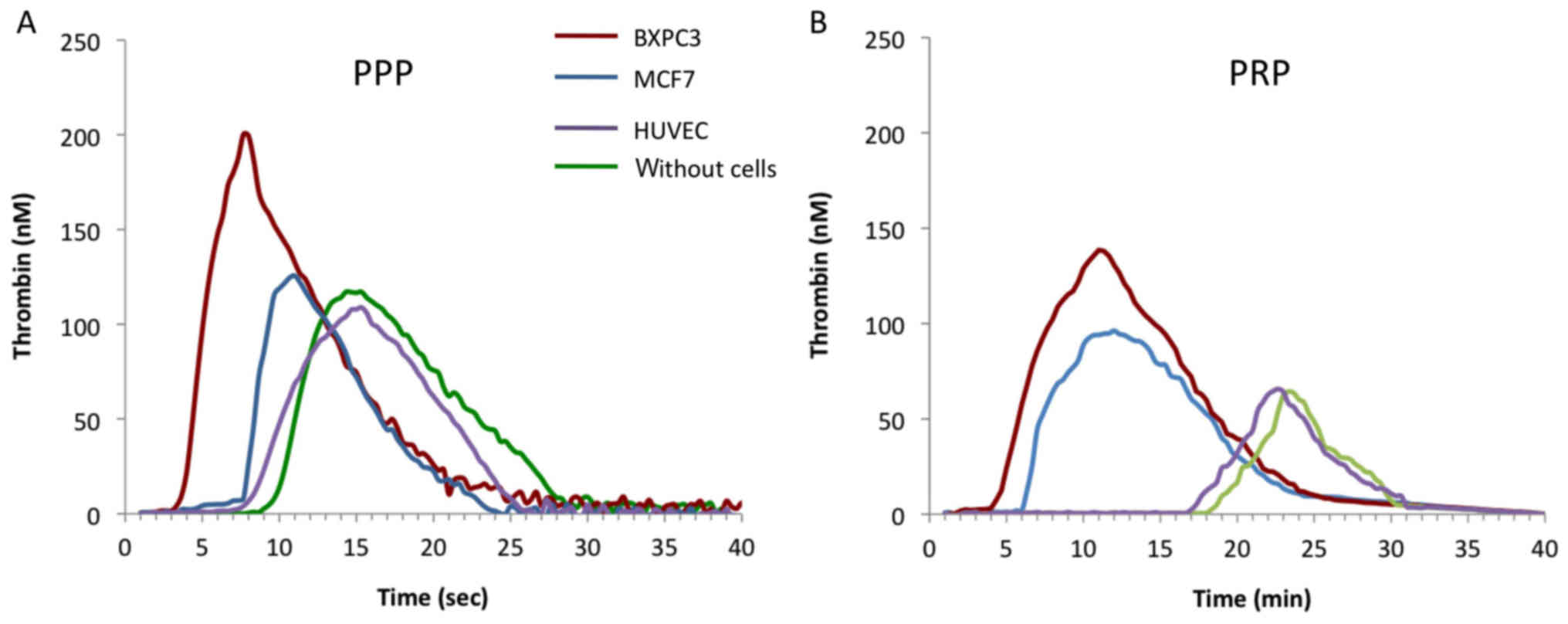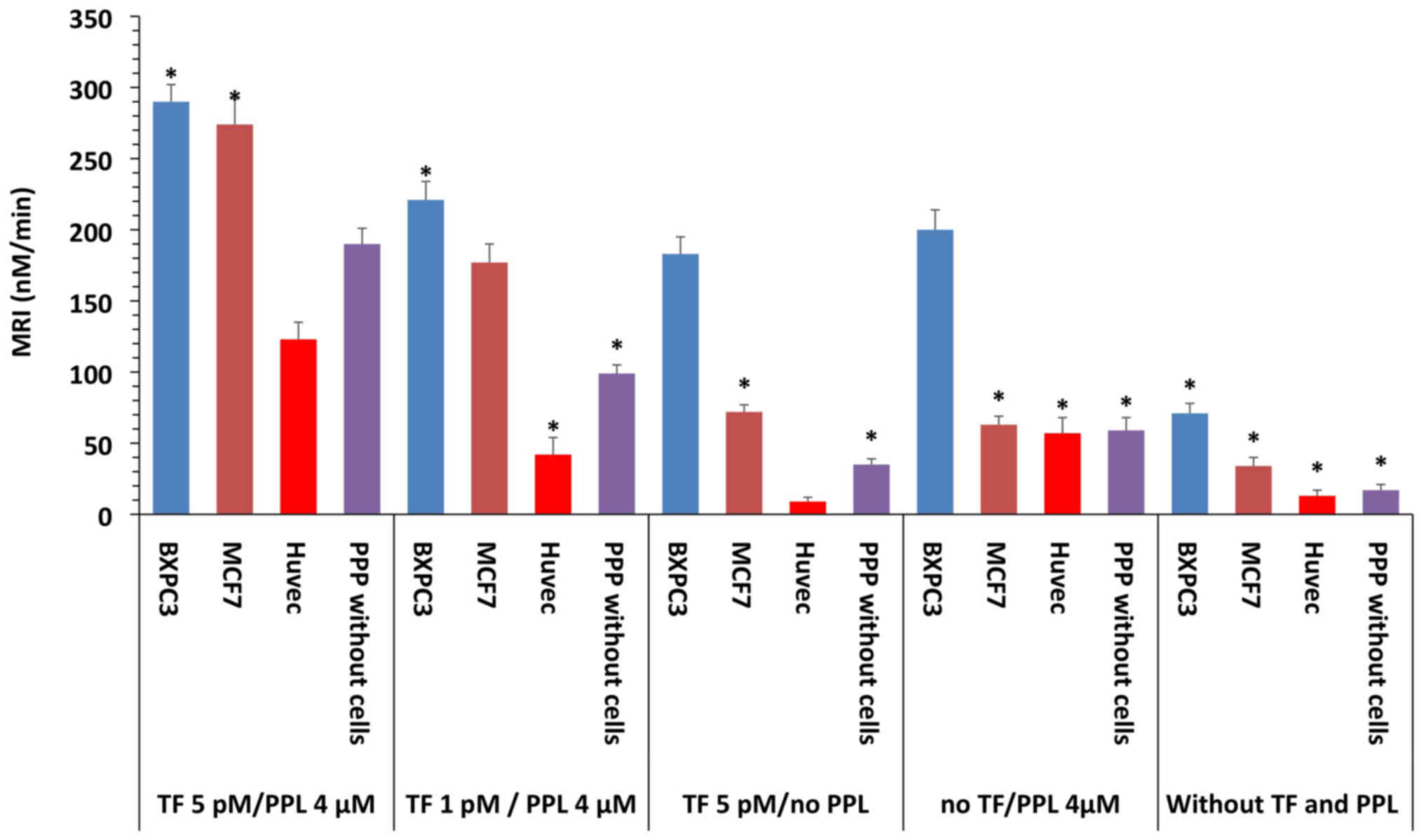|
1
|
Trousseau A: Clinique Médicale de
l'Hôtel-Dieu de Paris. 3. 2nd edition. JB Baillière; Paris: pp.
654–712. 1865
|
|
2
|
Falanga A, Russo L and Milesi V: The
coagulopathy of cancer. Curr Opin Hematol. 21:423–429. 2014.
View Article : Google Scholar : PubMed/NCBI
|
|
3
|
Khorana AA, Francis CW, Culakova E,
Kuderer NM and Lyman GH: Thromboembolism is a leading cause of
death in cancer patients receiving outpatient chemotherapy. J
Thromb Haemost. 5:632–634. 2007. View Article : Google Scholar : PubMed/NCBI
|
|
4
|
Chew HK, Wun T, Harvey D, Zhou H and White
RH: Incidence of venous thromboembolism and its effect on survival
among patients with common cancers. Arch Intern Med. 166:458–464.
2006. View Article : Google Scholar : PubMed/NCBI
|
|
5
|
Prandoni P, Falanga A and Piccioli A:
Cancer and venous thromboembolism. Lancet Oncol. 6:401–410. 2005.
View Article : Google Scholar : PubMed/NCBI
|
|
6
|
Lee AY and Levine MN: Venous
thromboembolism and cancer: Risks and outcomes. Circulation.
107(Suppl 1): I17–I21. 2003. View Article : Google Scholar : PubMed/NCBI
|
|
7
|
Caine GJ, Stonelake PS, Lip GY and Kehoe
ST: The hypercoagulable state of malignancy: Pathogenesis and
current debate. Neoplasia. 4:465–473. 2002. View Article : Google Scholar : PubMed/NCBI
|
|
8
|
De Cicco M: The prothrombotic state in
cancer: Pathogenic mechanisms. Crit Rev Oncol Hematol. 50:187–196.
2004. View Article : Google Scholar : PubMed/NCBI
|
|
9
|
Roberts HR, Hoffman M and Monroe DM: A
cell-based model of thrombin generation. Semin Thromb Hemost.
32(Suppl 1): 32–38. 2006. View Article : Google Scholar : PubMed/NCBI
|
|
10
|
Amin C, Mackman N and Key NS:
Microparticles and cancer. Pathophysiol Haemost thromb. 36:177–183.
2008. View Article : Google Scholar
|
|
11
|
Davila M, Amirkhosravi A, Coll E, Desai H,
Robles L, Colon J, Baker CH and Francis JL: Tissue factor-bearing
microparticles derived from tumor cells: Impact on coagulation
activation. J Thromb Haemost. 6:1517–1524. 2008. View Article : Google Scholar : PubMed/NCBI
|
|
12
|
Rauch U and Nemerson Y: Circulating tissue
factor and thrombosis. Curr Opin Hematol. 7:273–277. 2000.
View Article : Google Scholar : PubMed/NCBI
|
|
13
|
Butenas S, Orfeo T and Mann KG: Tissue
factor activity and function in blood coagulation. Thromb Res.
122(Suppl 1): S42–S46. 2008. View Article : Google Scholar : PubMed/NCBI
|
|
14
|
Mackman N: The role of tissue factor and
factor VIIa in hemostasis. Anesth Analg. 108:1447–1452. 2009.
View Article : Google Scholar : PubMed/NCBI
|
|
15
|
Mutch NJ: Emerging roles for factor XII in
vivo. J Thromb Haemost. 9:1355–1358. 2011. View Article : Google Scholar : PubMed/NCBI
|
|
16
|
Müller F and Renné T: Novel roles for
factor XII-driven plasma contact activation system. Curr Opin
Hematol. 15:516–521. 2008. View Article : Google Scholar : PubMed/NCBI
|
|
17
|
Thomassen MC, Heinzmann AC, Herfs L,
Hartmann R, Dockal M, Scheiflinger F, Hackeng TM and Rosing J:
Tissue factor-independent inhibition of thrombin generation by
tissue factor pathway inhibitor-α. J Thromb Haemost. 13:92–100.
2015. View Article : Google Scholar
|
|
18
|
Nickel KF, Ronquist G, Langer F, Labberton
L, Fuchs TA, Bokemeyer C, Sauter G, Graefen M, Mackman N, Stavrou
EX, et al: The polyphosphate-factor XII pathway drives coagulation
in prostate cancer-associated thrombosis. Blood. 126:1379–1389.
2015. View Article : Google Scholar : PubMed/NCBI
|
|
19
|
Gordon SG and Mielicki WP: Cancer
procoagulant: A factor X activator, tumor marker and growth factor
from malignant tissue. Blood Coagul Fibrinolysis. 8:73–86. 1997.
View Article : Google Scholar : PubMed/NCBI
|
|
20
|
Donati MB, Gambacorti-Passerini C, Casali
B, Falanga A, Vannotti P, Fossati G, Semeraro N and Gordon SG:
Cancer procoagulant in human tumor cells: Evidence from melanoma
patients. Cancer Res. 46:6471–6474. 1986.PubMed/NCBI
|
|
21
|
Gerotziafas GT, Galea V, Mbemba E,
Khaterchi A, Sassi M, Baccouche H, Prengel C, van Dreden P, Hatmi
M, Bernaudin JF, et al: Tissue factor over-expression by human
pancreatic cancer cells BXPC3 is related to higher prothrombotic
potential as compared to breast cancer cells MCF7. Thromb Res.
129:779–786. 2012. View Article : Google Scholar
|
|
22
|
Marchetti M, Diani E, Ten Cate H and
Falanga A: Characterization of the thrombin generation potential of
leukemic and solid tumor cells by calibrated automated
thrombography. Haematologica. 97:1173–1180. 2012. View Article : Google Scholar : PubMed/NCBI
|
|
23
|
Van Dreden P, Rousseau A, Savoure A,
Lenormand B, Fontaine S and Vasse M: Plasma thrombomodulin
activity, tissue factor activity and high levels of circulating
procoagulant phospholipid as prognostic factors for acute
myocardial infarction. Blood Coagul Fibrinolysis. 20:635–641. 2009.
View Article : Google Scholar : PubMed/NCBI
|
|
24
|
Rousseau A, Favier R and Van Dreden P:
Elevated circulating soluble thrombomodulin activity, tissue factor
activity and circulating procoagulant phospholipids: New and useful
markers for pre-eclampsia? Eur J Obstet Gynecol Reprod Biol.
146:46–49. 2009. View Article : Google Scholar : PubMed/NCBI
|
|
25
|
Schneider P, Van Dreden P, Rousseau A,
Kassim Y, Legrand E, Vannier JP and Vasse M: Increased levels of
tissue factor activity and procoagulant phospholipids during
treatment of children with acute lymphoblastic leukaemia. Br J
Haematol. 148:582–592. 2010. View Article : Google Scholar
|
|
26
|
Hemker HC, Giesen P, AlDieri R, Regnault
V, de Smed E, Wagenvoord R, Lecompte T and Béguin S: The calibrated
automated thrombogram (CAT): A universal routine test for hyper-
and hypocoagulability. Pathophysiol Haemost Thromb. 32:249–253.
2002. View Article : Google Scholar
|
|
27
|
Gerotziafas GT, Depasse F, Busson J,
Leflem L, Elalamy I and Samama MM: Towards a standardization of
thrombin generation assessment: the influence of tissue factor,
platelets and phospholipids concentration on the normal values of
Thrombogram-Thrombinoscope assay. Thromb J. 3:162005. View Article : Google Scholar : PubMed/NCBI
|
|
28
|
Tilley RE, Holscher T, Belani R, Nieva J
and Mackman N: Tissue factor activity is increased in a combined
platelet and microparticle sample from cancer patients. Thromb Res.
122:604–609. 2008. View Article : Google Scholar : PubMed/NCBI
|
|
29
|
Key NS, Chantrathammachart P, Moody PW and
Chang JY: Membrane microparticles in VTE and cancer. Thromb Res.
125(Suppl 2): S80–S83. 2010. View Article : Google Scholar : PubMed/NCBI
|
|
30
|
Zwicker JI, Liebman HA, Neuberg D, Lacroix
R, Bauer KA, Furie BC and Furie B: Tumor-derived tissue
factor-bearing microparticles are associated with venous
thromboembolic events in malignancy. Clin Cancer Res. 15:6830–6840.
2009. View Article : Google Scholar : PubMed/NCBI
|
|
31
|
Bogdanov VY, Kirk RI, Miller C, Hathcock
JJ, Vele S, Gazdoiu M, Nemerson Y and Taubman MB: Identification
and characterization of murine alternatively spliced tissue factor.
J Thromb Haemost. 4:158–167. 2006. View Article : Google Scholar : PubMed/NCBI
|
|
32
|
Böing AN, Hau CM, Sturk A and Nieuwland R:
Human alternatively spliced tissue factor is not secreted and does
not trigger coagulation. J Thromb Haemost. 7:1423–1426. 2009.
View Article : Google Scholar : PubMed/NCBI
|
|
33
|
Szotowski B, Antoniak S and Rauch U:
Alternatively spliced tissue factor: A previously unknown piece in
the puzzle of hemostasis. Trends Cardiovasc Med. 16:177–182. 2006.
View Article : Google Scholar : PubMed/NCBI
|
|
34
|
Censarek P, Bobbe A, Grandoch M, Schrör K
and Weber AA: Alternatively spliced human tissue factor (asHTF) is
not pro-coagulant. Thromb Haemost. 97:11–14. 2007.PubMed/NCBI
|
|
35
|
Spronk HM, Dielis AW, Panova-Noeva M, van
Oerle R, Govers-Riemslag JW, Hamulyák K, Falanga A and Cate HT:
Monitoring thrombin generation: Is addition of corn trypsin
inhibitor needed? Thromb Haemost. 101:1156–1162. 2009.PubMed/NCBI
|
|
36
|
van Veen JJ, Gatt A, Cooper PC, Kitchen S,
Bowyer AE and Makris M: Corn trypsin inhibitor in fluorogenic
thrombin-generation measurements is only necessary at low tissue
factor concentrations and influences the relationship between
factor VIII coagulant activity and thrombogram parameters. Blood
Coagul Fibrinolysis. 19:183–189. 2008. View Article : Google Scholar : PubMed/NCBI
|
|
37
|
Parhami-Seren B, Butenas S, Krudysz-Amblo
J and Mann KG: Immunologic quantification of tissue factors. J
Thromb Haemost. 4:1747–1755. 2006. View Article : Google Scholar : PubMed/NCBI
|
|
38
|
Berntorp E and Salvagno GL:
Standardization and clinical utility of thrombin-generation assays.
Semin Thromb Hemost. 34:670–682. 2008. View Article : Google Scholar : PubMed/NCBI
|












